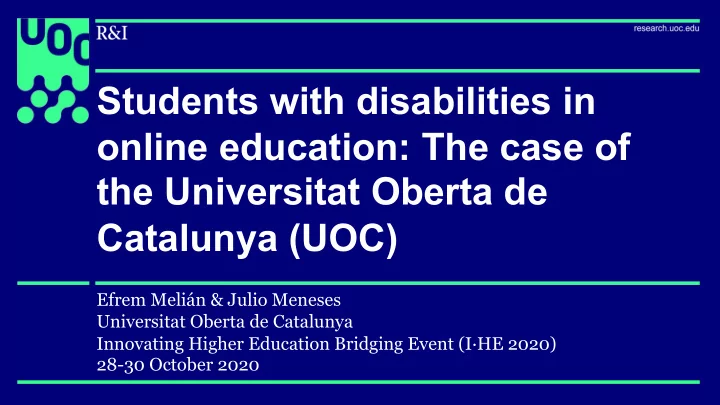

Students with disabilities in online education: The case of the Universitat Oberta de Catalunya (UOC) Efrem Melián & Julio Meneses Universitat Oberta de Catalunya Innovating Higher Education Bridging Event (I·HE 2020) 28-30 October 2020
About the UOC: The first fully online university in the world Created in Barcelona in 1994, the UOC is based on a 100% online educational model Among its foundational goals: ● Facilitating universal access to higher education ● Commitment to the inclusion of students with disabilities (SWD) The UOC in figures: ● 25 bachelor’s degrees, 54 master’s degrees, and 8 doctoral degrees ● 438 faculty members and research staff, and 4,721 affiliated teaching staff and counsellors ● 77,549 students, of which 1,722 are SWD . Which are 43% of Catalan SWD in the year 2018-2019, and make the UOC the 2nd university in Spain with the most SWD
About the UOC: An educational model based on e-learning ● Fully online & asynchronous ● Student-centred model ● Continuous assessment ● Intrinsically accessible campus ● Teaching materials in several formats ● Among the teaching staff, the tutor is a distinct UOC’s academic figure that accompanies every student throughout their whole academic journey, from (prior to) enrolment until graduation
Student Services and SWD: History and users’ profile SWD receive support from the general Student Services Unit Initiatives aimed at SWD over the years: ● Accessibility Commission (2009-2011) ● Group of accessibility leaders (2011-2012) ● 2 Disability Action Plans (2013-2014 and 2015-2016) ● Participation in national networks to improve SWD support (SAPDU, UNIDISCAT) Profile of UOC’s SWD: ● 51% women ● 86% between 30-60 years ● 82% with previous university studies ● Types: motor disabilities (37%), other physical disabilities (26%), mental disorders (15%), sensory disabilities (15%)
Student Services and SWD: Communicating students’ needs The Student Services Unit manages requests from students with not only disability certification but also any other justified special needs Virtual campus procedures addressed at requesting: ● Teaching accommodations ● Final tests accommodations ● On-site events accommodations Personnel involved in SWD support: ● Tutors ● Management staff (Student Services Unit) ● Faculty (coordinating professors and course instructors)
The experience of SWD at the UOC (I) Reasons why SWD choose online higher education: ● Overall accessibility to campus and materials; no need to commute ● Flexible schedule due to asynchronicity ● Disability becomes “ invisible” (less stigma & stress) However… Disclosure as a recurrent dilemma ● Half of the certified SWD never communicate their disability (and non-disclosure has ill effects) ● The initiative and burden of proof rest on the students’ side ● Disclosure implies (emotional) risks and recurrent negotiations with different agents ● Is there an even larger hidden SWD population?
The experience of SWD at the UOC (II) Two wide groups of disabilities: ● “ Traditional ”: i.e., motor, other physical, and sensory disabilities ● “ Emergent ”: i.e., learning challenges, ADHD, and mental disorders The complex case of the students with multiple disabilities The diversity of disabilities : ● Differences in identification with the SWD label (identity) ● Different institutional recognition ● Different needs and demands
Lessons learned ● The Student Services Unit was not conceived as a specific service for SWD ● The originally adopted generalistic approach made full sense within the context of the intrinsic accessibility of the UOC’s fully online model ● However, there has been an increase in both the number of SWD and the complexity of their needs over the years ● The current model of SWD support is under growing pressure and needs to be reconsidered ● Institutional plans and actions aimed at supporting SWD have been fragmented and have lacked consistency
Future developments ● Building a friendlier environment that celebrates diversity and proactively promotes disclosure of disabilities ● Improving staff training to enhance disability sensitivity and awareness and to promote a better understanding of the diverse needs of students with different types of disabilities (i.e., traditional, emergent, and multiple disabilities) ● Adopting a less bureaucratic, more simple, and flexible disclosure procedure ● Implementing more specialized support services to address this challenge ● Ensuring a personalized follow-up for all SWD throughout their academic journey ● Establishing a long-term, coherent institutional policy for the next years
Thank you! Photo by Yomex Owo on Unsplash View publication stats View publication stats
Recommend
More recommend